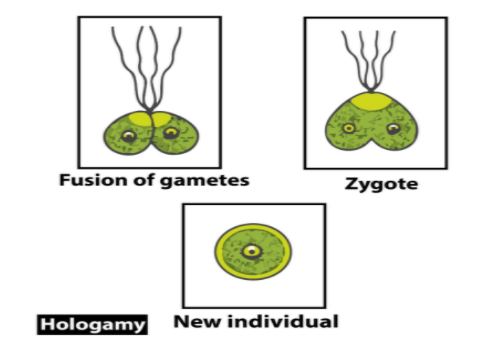
What is hologamy?
Answer
502.5k+ views
Hint: Fusion of the whole organism in the case of certain lower organisms and is the most simple type of sexual reproduction. In this case, the whole individuals fuse together to form a new organism.
Complete answer:
Hologamy is a specialized and simplest type of sexual reproduction in unicellular organisms. In these sex cells (gametes) are not formed, instead, the entire unicellular organisms get fused.
Hologamy is the characteristic feature of some green algae and lower fungi.
Additional Information: -In hologamy, the gametes are of the same size and structure as that of the somatic cells.
-It occurs in very lower algae which look alike and are haploid.
-Gametes are haploid having a single set of chromosomes that are produced by the organisms so that after fusion they can give rise to a new generation.
-Sexual reproduction is of various types:
(a)Allogamy – gametes join together during fertilization and they come from two different individuals.
(b)Internal fertilization – fertilization of the egg by the sperm within the body of one of the parents, usually in the female body through sexual intercourse.
(c)External fertilization – gametes join outside the body of an individual.
(d)Autogamy – a fusion of male and female gametes produced by single individuals. It is also known as self-fertilization.

Note: In fungi, sexual reproduction consists of three stages: Plasmogamy (fusion of two Protoplasts), Karyogamy (fusion of two haploid nuclei forming zygote), and Meiosis (cell division that reduces the chromosome number to one set per cell).
Complete answer:
Hologamy is a specialized and simplest type of sexual reproduction in unicellular organisms. In these sex cells (gametes) are not formed, instead, the entire unicellular organisms get fused.
Hologamy is the characteristic feature of some green algae and lower fungi.
Additional Information: -In hologamy, the gametes are of the same size and structure as that of the somatic cells.
-It occurs in very lower algae which look alike and are haploid.
-Gametes are haploid having a single set of chromosomes that are produced by the organisms so that after fusion they can give rise to a new generation.
-Sexual reproduction is of various types:
(a)Allogamy – gametes join together during fertilization and they come from two different individuals.
(b)Internal fertilization – fertilization of the egg by the sperm within the body of one of the parents, usually in the female body through sexual intercourse.
(c)External fertilization – gametes join outside the body of an individual.
(d)Autogamy – a fusion of male and female gametes produced by single individuals. It is also known as self-fertilization.

Note: In fungi, sexual reproduction consists of three stages: Plasmogamy (fusion of two Protoplasts), Karyogamy (fusion of two haploid nuclei forming zygote), and Meiosis (cell division that reduces the chromosome number to one set per cell).
Recently Updated Pages
Master Class 11 Economics: Engaging Questions & Answers for Success

Master Class 11 Business Studies: Engaging Questions & Answers for Success

Master Class 11 Accountancy: Engaging Questions & Answers for Success

Master Class 11 English: Engaging Questions & Answers for Success

Master Class 11 Computer Science: Engaging Questions & Answers for Success

Master Class 11 Maths: Engaging Questions & Answers for Success

Trending doubts
Which one is a true fish A Jellyfish B Starfish C Dogfish class 11 biology CBSE

State and prove Bernoullis theorem class 11 physics CBSE

1 ton equals to A 100 kg B 1000 kg C 10 kg D 10000 class 11 physics CBSE

In which part of the body the blood is purified oxygenation class 11 biology CBSE

One Metric ton is equal to kg A 10000 B 1000 C 100 class 11 physics CBSE

Difference Between Prokaryotic Cells and Eukaryotic Cells




